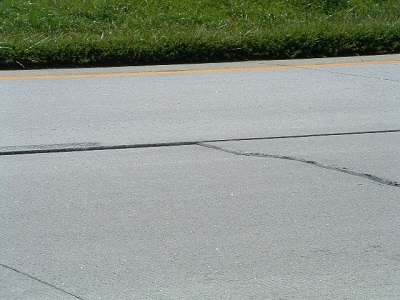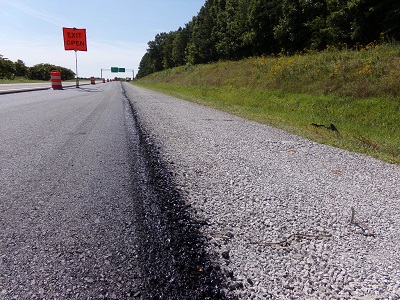Rubblization to the Rescue
Print this Article | Send to Colleague
In 1992, VDOT began construction of the Appomattox By-Pass in central Virginia. The 2.8-mile four-lane divided highway carried traffic around the historic town of Appomattox, the site where the Civil War ended. The 9-inch jointed plain concrete pavement was designed to last 20 or more years before rehabilitation – joint patching and grinding. Unfortunately, failures at the transverse joints, slab settlement, and development of mid-slab cracking (see Figure 1) were identified seven years after construction. Over the next 15 years, VDOT performed extensive repairs to maintain the roadway. Finally, a project awarded to Boxley in Lynchburg rescued the eastbound lanes – concrete rubblization.

Figure 1 - Mid-Slab Cracking and Slab Settlement
During the summer of 2018, Boxley’s sub-contractor Antigo has turned the deteriorated concrete into a high-quality aggregate base (see figure 2) using a series of breaking heads. Once rubblized, Boxley has placed a 4-inch high-modulus high-binder asphalt base course followed by a 2-inch intermediate layer and 1.5-inch surface.

Figure 2 - Rubblized Concrete Aggregate Base
Ken Arthur, Boxley’s Quality Control/Plant Operations Manager said, "The Appomattox Bypass project is one we’ve looked forward to for some time, and we were excited to see the Department select rubblization as the method of construction. This posed some learning-curve challenges as our last significant concrete overlay was a crack-and-seat of Route 29 between Lynchburg and Altavista in the early 90s. Other primary challenges centered around three overpasses where concrete had to be fully removed to maintain clearance along with traffic control transitions to adjoining ramps. Also, the finished rubblized concrete is serving as both a base and a drainage layer with a consistency closer to that of #57s than crusher-run. The high-binder BM-25.0D+0.8 gives us a better opportunity for long-term success with average field densities of 97%+ and asphalt contents around 5.2%. We also noticed distinct differences in rolling the high-modulus base over the rubblized concrete as opposed to the dense-graded stone under the overpasses. The loose characteristics of the concrete allowed some movement of the mat that reflected initially in the ride quality. These imperfections improved considerably with the installation of the intermediate layer above."
Learning from the positive experience of the Terminal Boulevard rubbilization in the Hampton Roads District, the Lynchburg District addressed a long-term maintenance issue on US 460. Scheduled for completion in September, the rehabilitated eastbound lanes will provide a smooth, long-lasting, perpetual pavement for the travelers on US 460. Rubblization and other concrete fracturing techniques offer solutions to rehabilitate Virginia’s aging concrete and composite pavement structures. To see this project in action visit the VAA YouTube channel.
